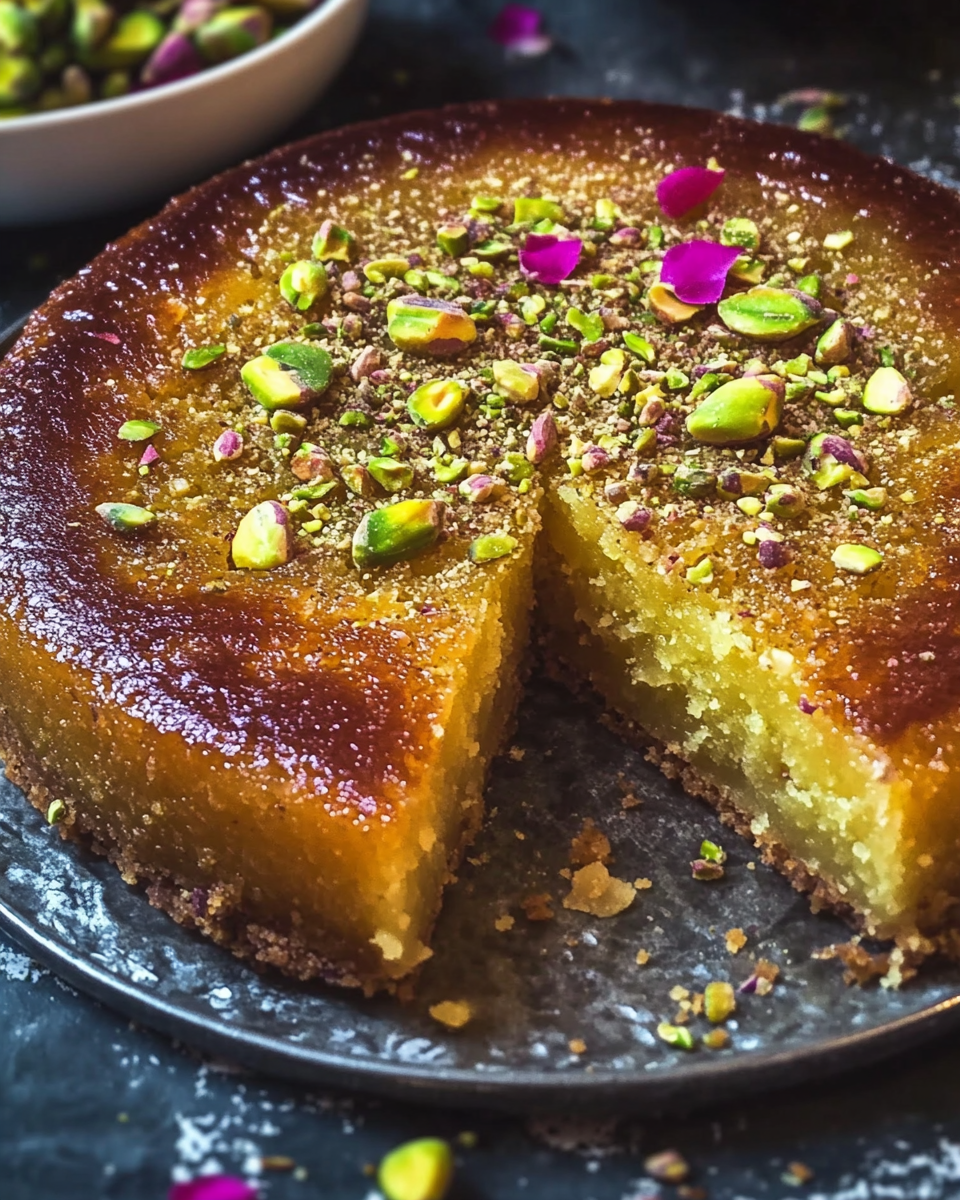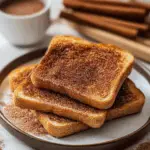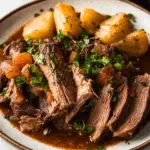The Saffron Pistachio Basbousa is a rich and aromatic semolina cake inspired by traditional Middle Eastern desserts. It features a deeply comforting combination of warm saffron milk, floral cardamom, buttery texture, and crunchy pistachios—all soaked in a sweet syrup kissed with lemon and optional rose water. Each bite delivers a balance of nutty richness and fragrant sweetness that’s ideal for tea-time or festive celebrations. What makes this dessert truly special is its simplicity and cultural roots. With minimal prep and a short baking time, it delivers big on flavor and texture. Whether you’re entertaining guests or enjoying a quiet evening treat, this basbousa is sure to impress and transport your tastebuds straight to the streets of Beirut or Cairo. It’s best served warm with a hot cup of black tea or spiced coffee.
Full recipe:
Ingredients:
-
1 cup semolina
-
1/2 cup desiccated coconut
-
1/2 cup sugar
-
1/2 cup plain yogurt
-
1/4 cup melted unsalted butter
-
1 tsp baking powder
-
1/2 tsp ground cardamom
-
1/4 tsp salt
-
1/4 tsp saffron threads, soaked in 2 tbsp warm milk
-
1/4 cup chopped pistachios (plus more for topping)
For the sugar syrup:
-
3/4 cup sugar
-
1/2 cup water
-
1 tsp lemon juice
-
1 tsp rose water (optional)
Directions:
-
Preheat the oven to 350°F (175°C). Grease a small baking pan (8×8 inch works well).
-
In a mixing bowl, combine semolina, coconut, sugar, yogurt, melted butter, baking powder, cardamom, salt, and saffron milk. Mix until a smooth, thick batter forms.
-
Fold in the chopped pistachios.
-
Spread the batter evenly into the greased baking pan and smooth the top with a spatula.
-
Score the top into squares or diamond shapes, then press a whole pistachio into each piece.
-
Bake for 30–35 minutes or until golden and a toothpick inserted comes out clean.
-
Meanwhile, prepare the sugar syrup: In a saucepan, combine sugar, water, and lemon juice. Bring to a boil, then simmer for 8–10 minutes until slightly thickened. Add rose water at the end and stir.
-
Once the basbousa is baked, remove it from the oven and immediately pour the warm syrup evenly over the hot cake. Let it absorb completely.
-
Cool, cut along scored lines, and serve.
Prep Time: 10 minutes | Cooking Time: 35 minutes | Total Time: 45 minutes
Kcal: 220 kcal | Servings: 9 servings
The History and Origin of Basbousa
Basbousa is a beloved dessert across the Middle East and North Africa, with origins tracing back to the Levant and Egypt. Traditionally made with semolina, sweetened with sugar syrup, and flavored with coconut or rosewater, it’s known by various names depending on the country—Hareesa in Syria, Revani in Turkey, and Namoura in Lebanon. It’s a dessert passed down through generations, often featured during Ramadan, Eid, and special family gatherings.
What makes basbousa stand out is its simplicity and versatility. Unlike Western-style cakes that rely on frosting and fillings, basbousa gets its charm from the coarse texture of semolina, the rich flavor of ghee or butter, and a soak in syrup that transforms it into something luxuriously moist. The version with saffron and pistachios elevates this traditional treat to something more luxurious, adding a burst of golden color and an earthy, aromatic richness.
Why Saffron and Pistachios Make This Recipe Unique
Saffron, often called the “red gold,” is one of the most expensive and prized spices in the world. Just a pinch adds a golden hue and a floral, honey-like aroma to the dish. In Middle Eastern and Persian cooking, saffron symbolizes hospitality and celebration. Using it in this basbousa brings an extra layer of fragrance and visual appeal.
Pistachios, on the other hand, bring both color and texture. Their earthy, buttery crunch complements the moist and syrupy softness of the cake. Pistachios are not only delicious but also high in antioxidants, healthy fats, and protein—making them a heart-healthy choice that enhances both the flavor and the nutritional profile of this dessert.
The Role of Semolina and Yogurt
Semolina is a coarse flour made from durum wheat, commonly used in traditional Middle Eastern desserts. It gives basbousa its signature slightly grainy texture and golden color. Unlike fine flour, semolina absorbs syrup better and maintains a hearty, crumbly bite. This texture is essential to achieving the authentic mouthfeel of basbousa.
Yogurt is another vital ingredient in this recipe. It tenderizes the cake and provides moisture, creating a softer, lighter crumb. It also adds a subtle tanginess that balances the sweetness of the syrup. The yogurt-semolina combination ensures a melt-in-the-mouth experience without the heaviness of typical butter-based cakes.
Health Benefits of the Ingredients
While basbousa is certainly an indulgent treat, the ingredients used in this version bring a few health benefits:
-
Semolina: Rich in iron and B vitamins, and provides complex carbohydrates for steady energy release.
-
Pistachios: Full of antioxidants, fiber, and protein. They help with heart health, blood sugar balance, and even weight control in moderation.
-
Saffron: Contains compounds like crocin and safranal that have mood-lifting, antioxidant, and anti-inflammatory properties.
-
Yogurt: Offers probiotics, calcium, and protein, supporting gut health and bone strength.
Of course, moderation is key—but it’s nice to know this dessert offers more than just sweetness.
When and How to Serve Saffron Pistachio Basbousa
This basbousa is incredibly versatile. It can be served as a light dessert after meals, as part of a festive dessert spread, or with a cup of Arabic coffee or mint tea for an afternoon pick-me-up. It’s particularly popular during Ramadan as a post-iftar treat and makes a beautiful addition to Eid tables. Thanks to its syrup-soaked nature, it stays moist for several days, making it a great make-ahead option for entertaining.
For presentation, consider cutting it into diamond or square shapes and topping each piece with a whole pistachio or edible gold flakes for an elegant finish.
Tips for Perfect Basbousa Every Time
To make the perfect saffron pistachio basbousa, keep these tips in mind:
-
Don’t overmix the batter – Overmixing can develop gluten, leading to a tough cake. Mix just until combined.
-
Let the semolina absorb – If time allows, let the batter rest for 10–15 minutes before baking so the semolina can absorb moisture and soften.
-
Use warm syrup on hot cake – This helps the syrup penetrate better and results in a perfectly moist texture.
-
Score before baking – This makes it easier to cut after baking and gives the cake its classic look.
A Dessert with Cultural Significance
Basbousa isn’t just food—it’s a part of cultural identity. It represents comfort, tradition, and hospitality in Arab and Mediterranean households. Families pass down their unique versions of the recipe, often tweaking ingredients to match their local preferences or available resources. Adding ingredients like saffron and pistachios signifies refinement and care, often reserved for honored guests or special occasions.
In many homes, basbousa is made during weekends or festive periods, with children helping to press pistachios into the batter or grandparents guiding the syrup pour. It’s a multigenerational experience that binds families together over something sweet.
Why This Recipe Is the Best Version to Try
This specific saffron pistachio basbousa recipe hits the sweet spot—pun intended—between tradition and elegance. It honors the classic preparation while adding premium elements like saffron and pistachios. It’s not overly dense or dry like some versions can be, thanks to the balanced inclusion of yogurt and syrup. The coconut brings in subtle chewiness, while the cardamom adds depth and warmth.
Whether you’re new to Middle Eastern desserts or a seasoned fan, this recipe is accessible, rich in flavor, and visually stunning. It works beautifully for casual family dinners, formal celebrations, or gifting in small decorative boxes during the holidays.
How to Store and Reheat
Basbousa stores well at room temperature for up to 3 days when kept in an airtight container. For longer storage, refrigerate it for up to a week. If you want to freeze it, wrap individual pieces in plastic wrap and then place them in a freezer-safe container. To serve, simply reheat in the microwave for 10–15 seconds or warm in the oven to bring back the soft texture.
A quick splash of warm syrup before serving can also refresh its moistness if needed.
A Great Recipe for Beginners and Experts Alike
This saffron pistachio basbousa is not just for seasoned bakers. With no fancy equipment required and a forgiving batter, it’s a great starting point for those new to Middle Eastern desserts. It’s also an ideal “show-off” dessert for experienced bakers looking to impress guests without spending hours in the kitchen.
It’s gluten-free adaptable, egg-free, and uses pantry-friendly ingredients. The simplicity of the method paired with the complex flavor of the final result is what makes this recipe truly special.
Conclusion
Saffron Pistachio Basbousa is the kind of dessert that tells a story with every bite—a story of rich traditions, fragrant spices, and warm hospitality. It is proof that food can be both comforting and elegant, simple yet layered, and always a reason to gather around the table. Whether you’re baking it for the first time or returning to a childhood favorite, this recipe is sure to become a staple in your dessert repertoire. It’s not just a cake—it’s a celebration.






